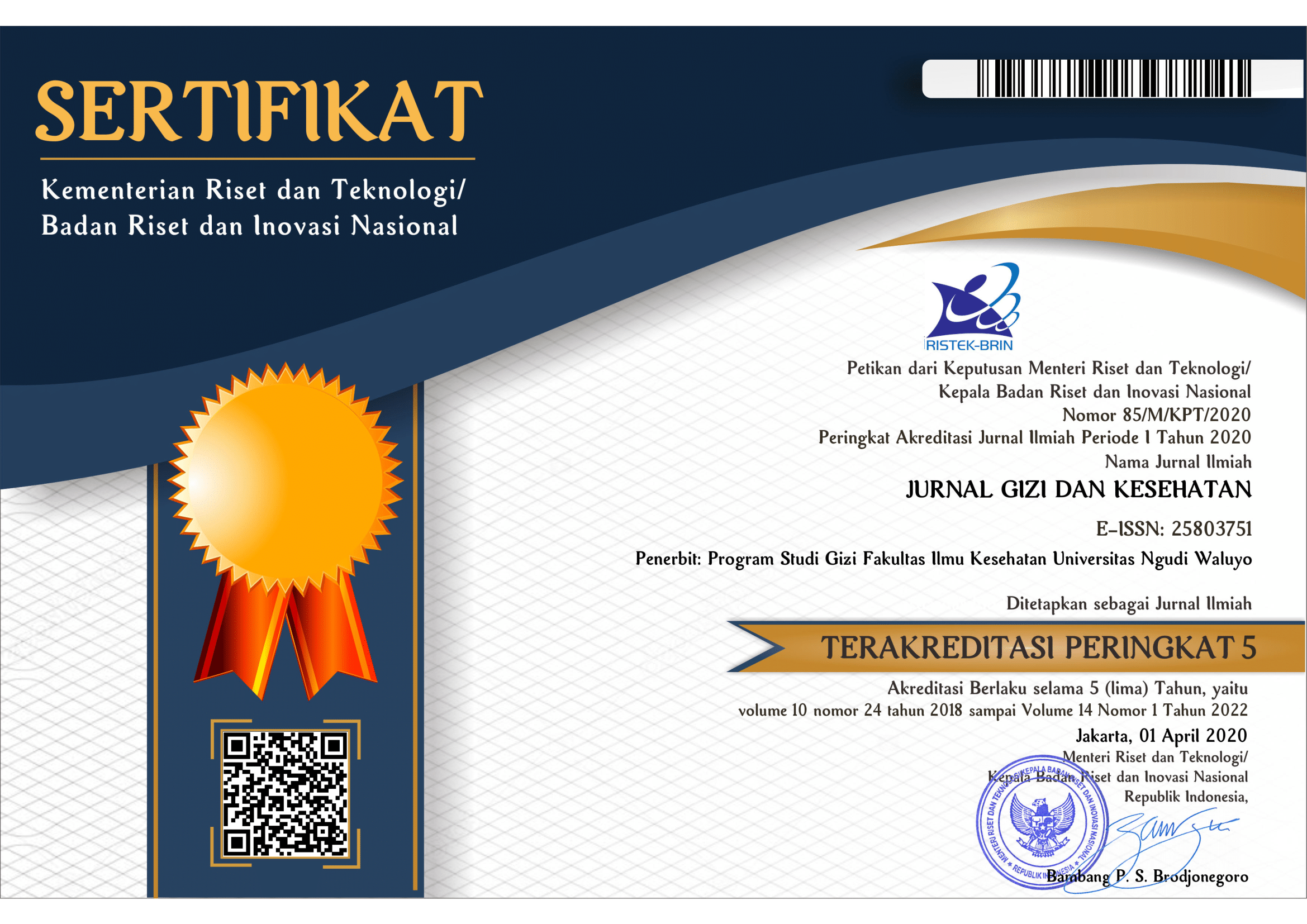Perbedaan Lingkar Lengan Atas (LILA) berdasarkan Kategori Status Gizi pada Remaja Putri di Kabupaten Kulonprogo
The Differences in Mid Upper Arm Circumference (MUAC) based on Adolescent Girsl’s Nutrition Status Category in Kulonprogo Regency
DOI:
https://doi.org/10.35473/jgk.v16i2.579Keywords:
LILA, IMT/U, Status Gizi, Remaja PutriAbstract
Nutritional disorders in adolescence will lead to adult health problem. Early detection of malnutrition in adolescents is important to prevent the risk of worsening nutritional status. MUAC can be used as an alternative nutritional status screening tool in adolescent girls that is easier and cheaper than BMI for Age Z-Score (BAZ). The aims of the study were to examine the correlation between MUAC and BAZ, & assess the difference of MUAC between nutritional status categories in adolescent girls. This study was a quantitative study by processing secondary data from Basic Data for Nutrition Program Planning, Department of Nutrition Poltekkes Kemenkes Yogyakarta, 2023. There were 213 data of adolescent girls (13-18 years) analyzed. Data Body Weight, Height and Age were processed using the WHO AnthroPlus application to obtain the BAZ and categorized into 3 thinnes, normal, and overweight. Spearman Rank Correlation Test was used to test the correlation of BAZ and MUAC. Kruskal Wallis Test was used to test the difference of MUAC between nutritional status categories. The Results showed there was correlation between MUAC and BAZ (rs; 0.749; p = <0.001) and there was differences in MUAC among nutritional status categories; thinness (Median=19,7; IQR=1,5, normal (Median=19,7; IQR=1,5), and overweight (Median= 27,1; IQR=4,0), (p <0.001). The correlation between MUAC and Z-Score BAZ, as well as differences in MUAC among the category of nutritional status in this study, can be used as a basis for evaluation and research development in determining the MUAC cut off for each category of nutritional status for adolescent girls in Indonesia.
ABSTRAK
Gangguan gizi pada masa remaja akan berdampak pada masalah kesehatan di masa depan. Deteksi dini malnutrisi pada remaja penting dilakukan untuk mencegah risiko memburuknya status gizi. LILA dapat digunakan sebagai alternatif alat skrining status gizi pada remaja putri yang lebih mudah dan murah dibandingkan IMT/U. Penelitian ini bertujuan menguji korelasi antara LILA dan nilai Z-Score IMT/U serta menilai perbedaan LILA berdasarkan kategori status gizi pada remaja putri. Penelitian ini merupakan penelitian kuantitatif dengan mengolah data sekunder (Data Dasar Perencanaan Program Gizi, Jurusan Gizi Poltekkes Kemenkes Yogyakarta tahun 2023). Sebanyak 213 data remaja putri berusia 13 -18 tahun dianalisis. Data Berat Badan (BB), Tinggi badan (TB) dan usia diolah menggunakan aplikasi WHO AnthroPlus untuk mendapatkan nilai Z-Score IMT menurut Usia (IMT/U) dan dikategorikan menjadi 3 yaitu gizi kurang, gizi baik, dan gizi lebih. Data diolah dengan menggunakan aplikasi IBM SPSS Statistics 27. Spearman Rank Correlation Test digunakan untuk menguji korelasi Z-Score IMT/U, LILA dan Usia, serta Kruskal Wallis Test digunakan untuk menguji perbedaan LILA antar kategori status gizi. Hasil penelitian menunjukkan ada korelasi antara LILA dan Z-Score IMT/U (rs; 0,749; p= <0,001) serta ada perbedaan LILA antar kategori status gizi; gizi kurang (Median =19,7; IQR=1,5), gizi baik (Median=19,7; IQR=1,5), dan gizi lebih (Median= 27,1; IQR=4,0), nilai p<0,001. Adanya korelasi antara LILA dan nilai Z-Score IMT/U serta perbedaan nilai LILA pada setiap kategori status gizi dalam penelitian ini, dapat digunakan sebagai dasar evaluasi dan pengembangan dalam menentukan cut off LILA pada setiap kategori status gizi remaja putri di Indonesia.
Downloads
References
Bates, C., Bogin, B., Holmes, B., 2017. Nutritional Assessment Methods, in: Human Nutrition. pp. 613–646.
BKPK, 2023. Survei Kesehatan Indonesia (SKI) Dalam Angka. Jakarta.
BPS, 2022. Jumlah Penduduk menurut Kelompok Umur dan Jenis Kelamin, INDONESIA, Tahun 2022. Jakarta.
Das, A., Saimala, G., Reddy, N., Mishra, P., Giri, R., Kumar, A., Raj, A., Kumar, G., Chaturvedi, S., Babu, S., Srikantiah, S., Mahapatra, T., 2020. Mid-upper arm circumference as a substitute of the body mass index for assessment of nutritional status among adult and adolescent females: learning from an impoverished Indian state. Public Health 179, 68–75. https://doi.org/10.1016/j.puhe.2019.09.010
Global nutrition challenges: a life-cycle approach, 2000. . Food Nutr Bull 21, 18–34.
Jaiswal, M., Bansal, R., Agarwal, A., 2017. Role of mid-upper arm circumference for determining overweight and obesity in children and adolescents. Journal of Clinical and Diagnostic Research 11, SC05–SC08. https://doi.org/10.7860/JCDR/2017/27442.10422
Musa, I.R., Omar, S.M., AlEed, A., Al-Nafeesah, A., Adam, I., 2023. Mid-upper arm circumference as a screening tool for identifying underweight adolescents. Front Nutr 10. https://doi.org/10.3389/fnut.2023.1200077
Nitika, -, 2021. Discriminatory performance of mid-upper arm circumference for identifying thin and severely thin adolescents: a secondary data analysis using Comprehensive National Nutrition Survey. Nepal J Epidemiol 11, 1023–1033. https://doi.org/10.3126/nje.v11i2.33926
Norris, S.A., Frongillo, E.A., Black, M.M., Dong, Y., Fall, C., Lampl, M., Liese, A.D., Naguib, M., Prentice, A., Rochat, T., Stephensen, C.B., Tinago, C.B., Ward, K.A., Wrottesley, S. V., Patton, G.C., 2022. Nutrition in adolescent growth and development. The Lancet. https://doi.org/10.1016/S0140-6736(21)01590-7
Okosun, O.A., Akinbami, F.O., Orimadegun, A.E., Tunde-Oremandu, I.I., 2019. Accuracy of mid upper arm circumference in detection of obesity among school children in Yenagoa City, South-south region of Nigeria. Niger J Paediatr 46, 48. https://doi.org/10.4314/njp.v46i2.2
Renyoet, B.S., Dary Dary, Christantya Vita Rena Nugroho, 2023. Intervensi pada Remaja Perempuan 8000 Hari Pertama Kehidupan (HPK) sebagai Upaya Pencegahan Stunting pada Generasi di Masa Depan: Literatur Review. Amerta Nutrition 7, 295–306. https://doi.org/10.20473/amnt.v7i2.2023.289 300
Serón-Arbeloa, C., Labarta-Monzón, L., Puzo-Foncillas, J., Mallor-Bonet, T., Lafita-López, A., Bueno-Vidales, N., Montoro-Huguet, M., 2022. Malnutrition Screening and Assessment. Nutrients 14. https://doi.org/10.3390/nu14122392
Sisay, B.G., Haile, D., Hassen, H.Y., Gebreyesus, S.H., 2021. Mid-upper arm circumference as a screening tool for identifying adolescents with thinness. Public Health Nutr 24, 457–466. https://doi.org/10.1017/S1368980020003869
Sisay, B.G., Haile, D., Hassen, H.Y., Gebreyesus, S.H., 2020. Performance of mid-upper arm circumference as a screening tool for identifying adolescents with overweight and obesity. PLoS One 15. https://doi.org/10.1371/journal.pone.0235063
WHO, 2024. Overweight in school-age children and adolescents [WWW Document]. URL https://www.who.int/tools/growth-reference-data-for-5to19-years/indicators/bmi-for-age (accessed 7.12.24).
WHO, 2007. BMI-for-age (5-19 years) [WWW Document]. URL https://www.who.int/tools/growth-reference-data-for-5to19-years/indicators/bmi-for-age (accessed 7.12.24).









